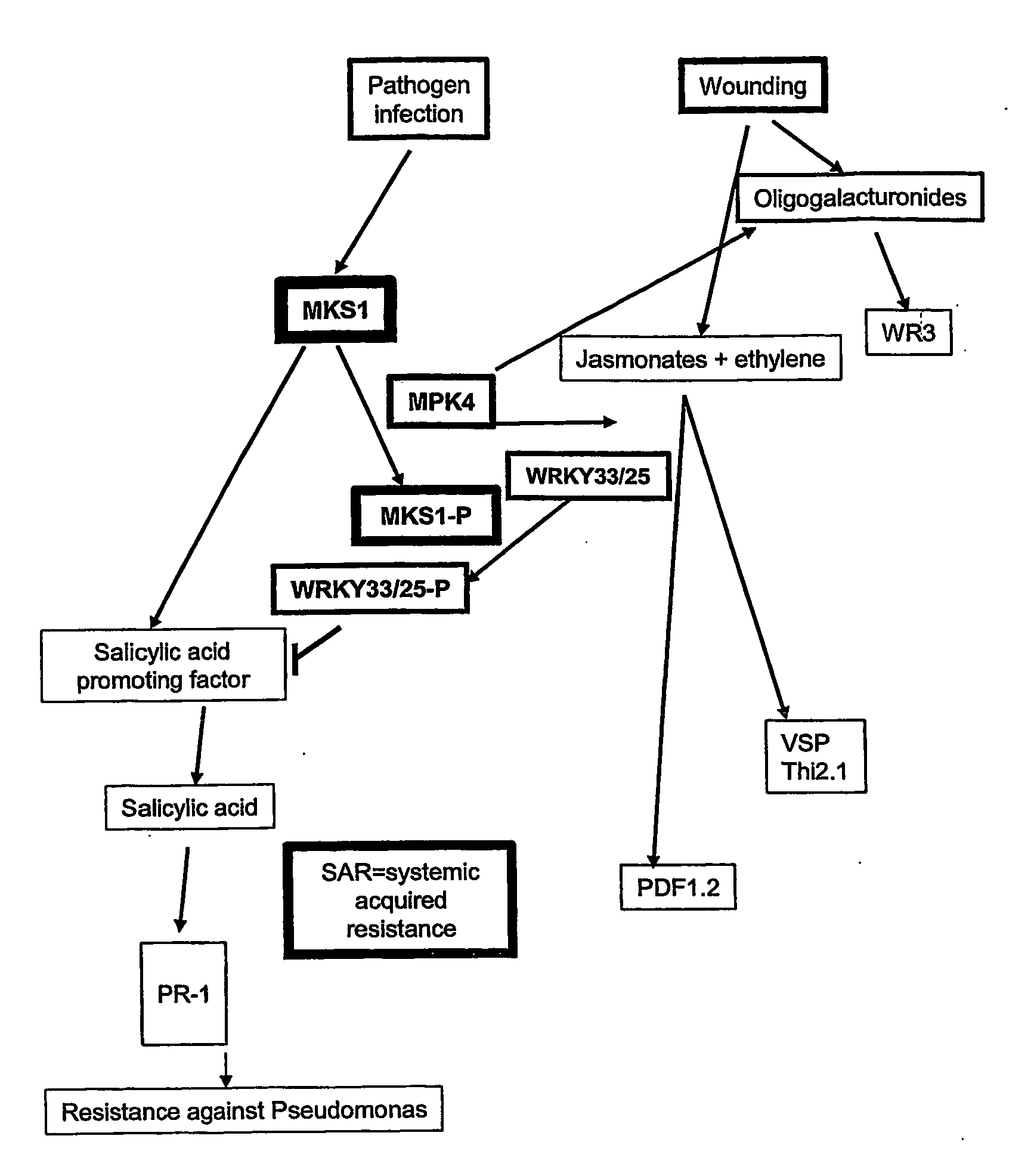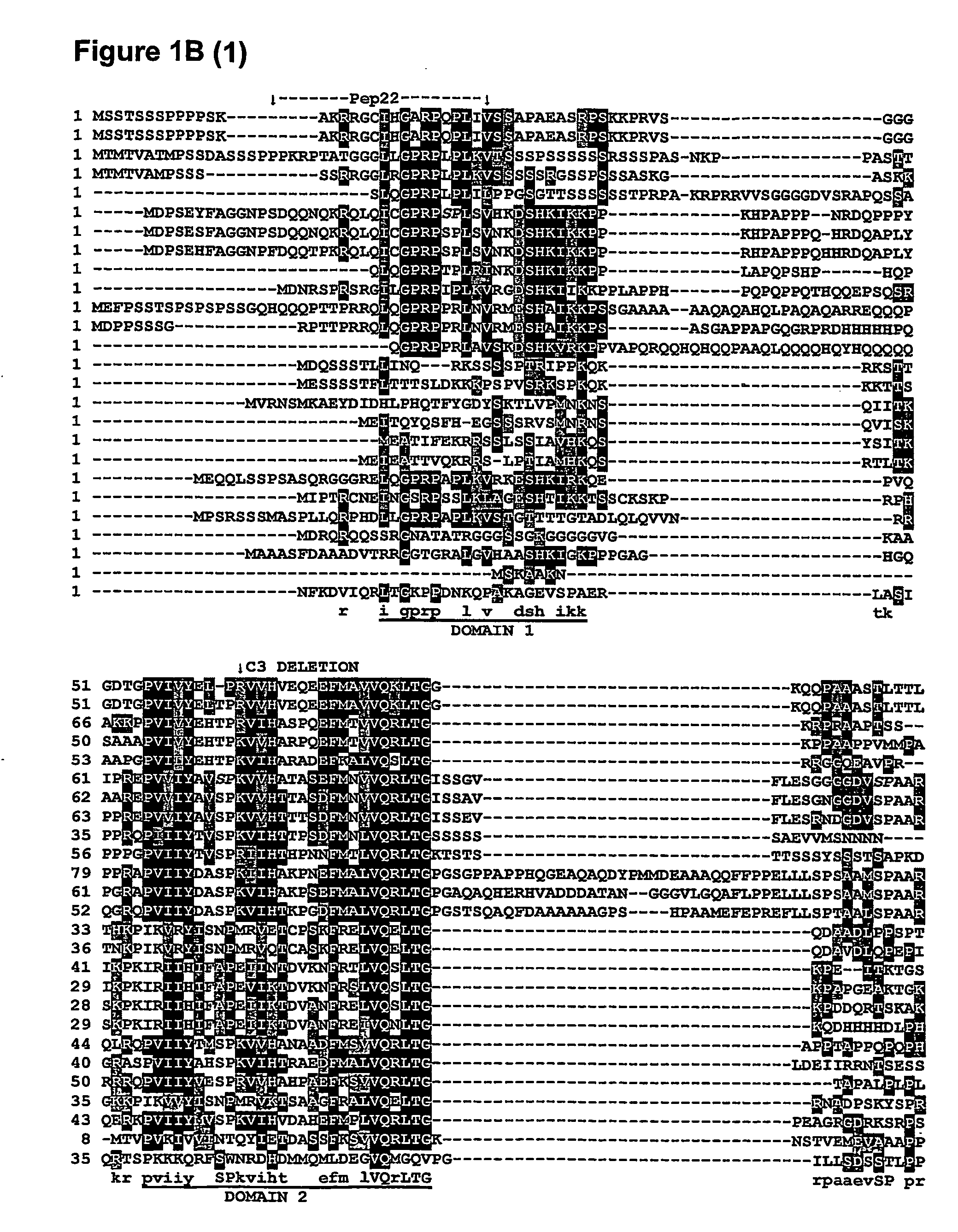Plant Disease Resistance and Sar Regulator Protein
a plant disease resistance and sar technology, applied in the field of plant disease resistance and sar regulator protein, can solve the problems of low natural resistance, serious man-made problem, and particularly vulnerable monocultures of genetically uniform plants to attack, so as to increase the sar in plants, increase the resistance to pathogen attack, and promote the effect of sa synthesis and pr gene expression
- Summary
- Abstract
- Description
- Claims
- Application Information
AI Technical Summary
Benefits of technology
Problems solved by technology
Method used
Image
Examples
example 1
Arabidopsis MAP Kinase Substrate 1 (MKS1) Interacts with MPK4
[0107] A yeast two-hybrid screen was employed to identify proteins that interact with the MPK4 protein. The yeast two-hybrid screen, first described by Fields and Song in 1989 (Nature 340: 245-24) is a common method used to detect protein-protein interactions. This screen exploits inherent properties of transcription factors, namely that are composed of two separate domains: a DNA-binding domain and a transcription activation domain. A physical association of the two domains of a transcription factor is required in order for it to bind to a promoter and activate transcription of a downstream gene. DNA sequences encoding fusion proteins, comprising the DNA-binding domain or the activation domain of a transcription factor, can be constructed and co-expressed in yeast. Interaction between the two fusion proteins will result in a functional transcription factor. If a DNA binding domain-MPK4 fusion protein (bait), and an activ...
example 2
Arabidopsis MPK4 Interacts with and Phosphorylates MKS1 In Vitro
A. MPK4-MKS1 Interaction In Vitro
[0112] To substantiate the interaction between MPK4 and MKS1, detected in the yeast two-hybrid screen, in vitro interaction assays (pull-down assays) were performed with recombinant MPK4 and MKS1 proteins. Recombinant MKS1 was obtained by bacterial expression according to the following procedure. The full-length MKS1 coding sequence (At3g18690 nucleotides 80 to 748) was cloned in-frame with the glutathione-S-transferase (GST) gene in the Xho I site of pGEX-5× plasmid (www: amershambiosciences.com). Expression of the recombinant protein in E. coli BL21 (pLysS) cells (www:novagen.com) was induced with 0.1 mM isopropyl-β-D-thiogalactopyranoside (IPTG) at 30° C. for 3-4 h, and 2% ethanol was added before induction. GST protein was similarly expressed in E. coli from the pGEX-5× plasmid. GST and GST-fusion proteins were purified from whole cell extracts of E. coli by binding to glutathione...
example 3
Antibodies for MKS1 Detection
[0123] To provide tools for the detection of MKS1 expression in vitro or in vivo in single or multicellular organisms, polyclonal (pa-Pep22) and monoclonal antibodies (ma-Pep22 & ma-Pep22p) were raised against the peptide Pep22 (SDQQNQKRQLQICGPRPSPLSVH), corresponding to amino acid residues 13-35 of MKS1. Ten to twelve-week old female Balb / cCF1 F1-hybrid mice were used to raise both polyclonal and monoclonal antibodies. The mice were primed with 0.2 mL live BCG vaccine, delivered intraperitoneally. One month later the mice were immunised with the antigen Pep22 coupled to PPD (Purified Protein Derivative; Bardarov et al. 1990, FEMS Microbiology Letters 71: 89-94), absorbed onto the adjuvant Al(OH)3. The total volume of vaccine per immunisation was 500 μL, containing 15 μg of PPD and 1 mg of adjuvant. The antigen was injected intraperitoneally at 2-week intervals. To prepare polyclonal antibodies from the immunised mice, blood samples were collected 10 da...
PUM
| Property | Measurement | Unit |
|---|---|---|
| molar ratios | aaaaa | aaaaa |
| molar ratios | aaaaa | aaaaa |
| temperature | aaaaa | aaaaa |
Abstract
Description
Claims
Application Information
 Login to View More
Login to View More - R&D
- Intellectual Property
- Life Sciences
- Materials
- Tech Scout
- Unparalleled Data Quality
- Higher Quality Content
- 60% Fewer Hallucinations
Browse by: Latest US Patents, China's latest patents, Technical Efficacy Thesaurus, Application Domain, Technology Topic, Popular Technical Reports.
© 2025 PatSnap. All rights reserved.Legal|Privacy policy|Modern Slavery Act Transparency Statement|Sitemap|About US| Contact US: help@patsnap.com



